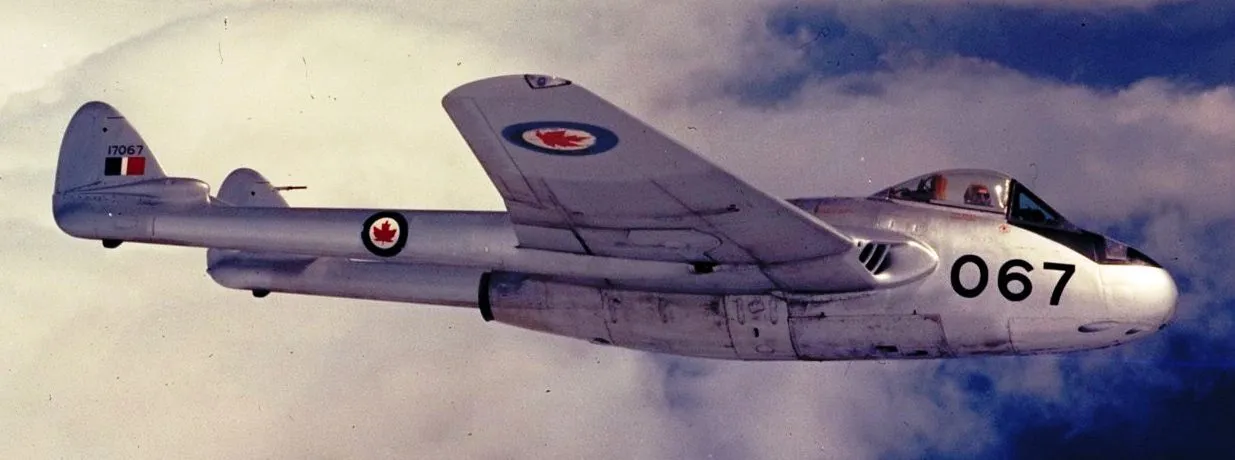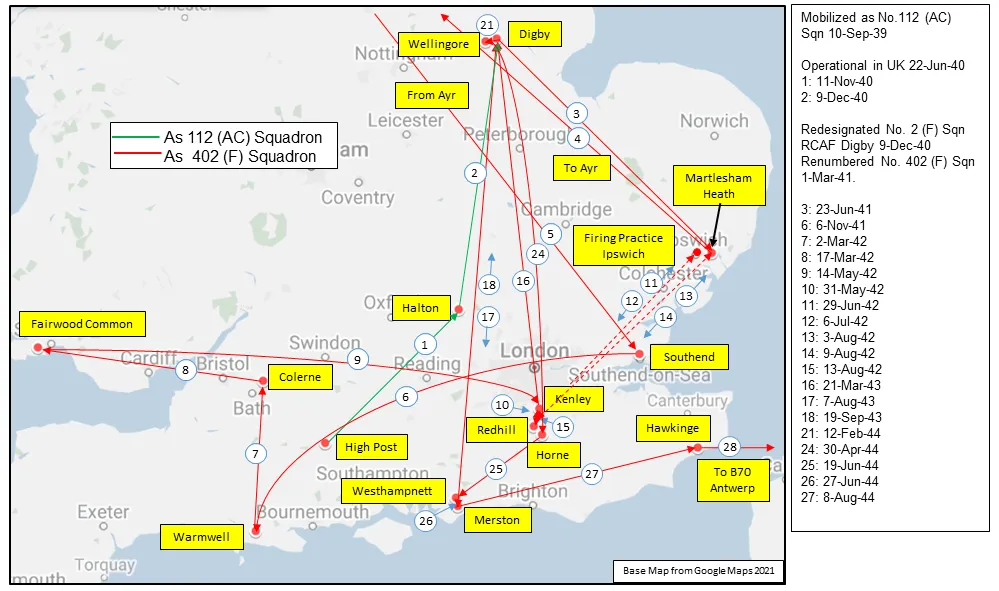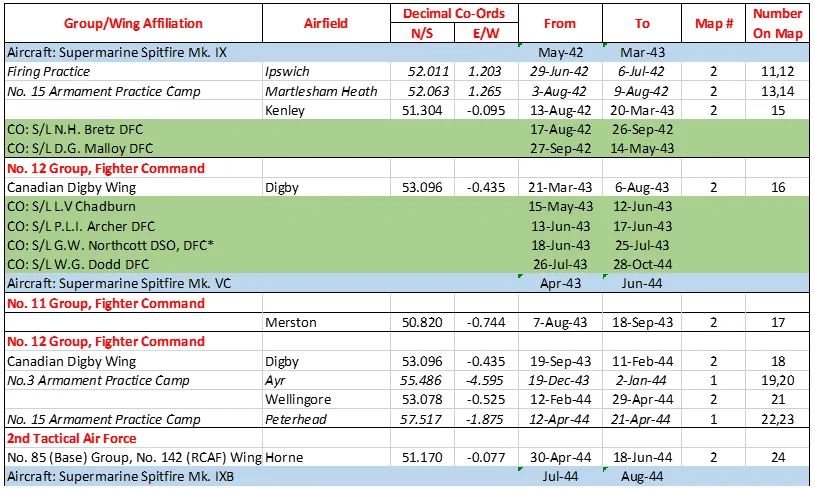Bastable, Vernon James (Flying Officer)
Killed in Flying Accident 1949-March-27


Birth Date: 1914-December-02
Born: Winnipeg, Manitoba
Parents: Son of Denis and Elizabeth Bastable of St. James, Manitoba.
Spouse: Husband of Phylis. Father of Sandra and Terrence.
Home: Winnipeg, Manitoba
Enlistment:
Enlistment Date: unkown date
Service
RCAF
Unit
402 Sqn- Squadron
We Stand on Guard
Base
Rank
Flying Officer
Position
Pilot
Service Numbers
120214
Crew or Other Personnel
Vampire 17032
Vampire serial: 17032

de Havilland DH.100 Vampire, RCAF (Serial No. 17067), No. 411 "County of York" Squadron (Auxiliary), Toronto, Ontario
The de Havilland Vampire is a British jet fighter which was developed and manufactured by the de Havilland Aircraft Company. It was the second jet fighter to be operated by the RAF, after the Gloster Meteor, and the first to be powered by a single jet engine.
Development of the Vampire as an experimental aircraft began in 1941 during the Second World War, to exploit the revolutionary innovation of jet propulsion. From the company's design studies, it was decided to use a single-engine, twin-boom aircraft, powered by the Halford H.1 turbojet (later produced as the "Goblin"). Aside from its propulsion system and twin-boom configuration, it was a relatively conventional aircraft. In May 1944 it was decided to produce the aircraft as an interceptor for the Royal Air Force (RAF). In 1946 the Vampire entered operational service with the RAF, only months after the war had ended.
The Vampire quickly proved to be effective and was adopted as a replacement of wartime piston-engined fighter aircraft. During its early service it accomplished several aviation firsts and achieved various records, such as being the first jet aircraft to cross the Atlantic Ocean. The Vampire remained in front-line RAF service until 1953 when it was progressively reassigned to various secondary roles, such as ground attack and pilot training, for which specialist variants were produced. The RAF retired the Vampire in 1966 when its final role of advanced trainer was filled by the Folland Gnat. The Royal Navy had also adapted the type as the Sea Vampire, a navalised variant suitable for operations from aircraft carriers. It was the service's first jet fighter.
The Vampire was exported to a wide variety of nations and was operated worldwide in numerous theatres and climates. Several countries deployed the type in combat during conflicts, including the Suez Crisis, the Malayan Emergency, and the Rhodesian Bush War. By the end of production, almost 3,300 Vampires had been manufactured, a quarter of these having been manufactured under licence in several other countries.
The layout of the DH.100 used a single jet engine installed in an egg-shaped fuselage which was primarily composed of plywood for the forward section and aluminium throughout the aft section. It was furnished with conventional mid-mounted straight wings; air brakes were installed on the wings to slow the aircraft, a feature that had also been incorporated in the Meteor. Armament comprised four 20 mm Hispano Mk V cannon located underneath the nose; from the onset of the design phase, even when the aircraft was officially intended to serve only as an experimental aircraft, the provision for the cannon armament had been included.
In 1946, a single Vampire F.1 began operating on an evaluation basis in Canada at the Winter Experimental Establishment in Edmonton. The Vampire F.3 was selected as one of two types of operational fighters for the Royal Canadian Air Force (RCAF) and was first flown in Canada on 17 January 1948 where it went into service as a Central Flying School training aircraft at RCAF Station Trenton. Operating a total of 86 aircraft, the Vampire F.3 became the first jet fighter to enter RCAF service in any significant numbers.
The Vampire had the function of introducing Canadian fighter pilots not only to jet propulsion, but also to other amenities such as cockpit pressurisation and the tricycle landing gear arrangement. It proved to be a popular aircraft, being easy to fly and often considered a "hot rod". In Canadian service, the Vampire served in both operational and air reserve units (400, 401, 402, 411, 438 and 442 squadrons). During the late 1950s, the type was retired and was replaced in RCAF service by the Canadair Sabre. Wikipedia
After retirement, 26 of the surplus RCAF Vampires were sold to the Formetal Division of Fliteways Inc., West Bend, Wisconsin, USA in 1958. Another 4 airframes were to provide spares. Aerial Blight Control, also of West Bend, refurbished 15 Vampires for sale to the Mexican Air Force starting in 1959. The FAM operated the Vampires until about 1970. Several of the remaining Vampires purchased by Fliteways found their way to the US civil market. Some may now be found in museums in Mexico, the U.S. or Canada.
Unit Desciption
402 Sqn We Stand on Guard ("City of Winnipeg")
History of the Squadron before and during World War II (Aircraft: DH-60 Moth, Lysander 1, Hurricane I, IIA, IIB, IIB(B), Spitfire V, VC, IX, IXB, XIVE, XVI)

Note that the crest and motto were not granted until after WWII. During the war the squadron had no crest or motto
402 Squadron evolved from No 112 Army Co-operation Squadron (Auxiliary), which was formed at Winnipeg, MB in October 1932, although it did not begin flying training until September 1934, when it received de Havilland DH-60 Moth aircraft. It was renumbered as No 112 Squadron in November 1938. It was mobilized in September 1939 and was assigned to the Canadian Active Service Force for overseas duty and moved to Rockcliffe, ON in February of 1940, being equipped with Westland Lysander Mk. II aircraft with the squadron code XO. It embarked for Britain on 9 June 1940 to join RAF Army Co-operation Command, but the fighting in France was over before the squadron could become operational. On arrival to England, the squadron code was changed to AE. The unit remained with Army Co-operation Command until December 9, 1940, when it transferred to Digby, Lincolnshire, UK 
and was re-designated No 2 (Fighter) Squadron. On March 1, 1941, it was renumbered No 402 (Fighter) Squadron. The squadron was issued with Hawker Hurricane Mk I’s, but these were followed by Hurricane IIB and IIB(B) versions. The latter were the fighter-bomber versions of the aircraft ("Hurribombers"), and the squadron was the first RCAF unit to be equipped with them. The first bombing sortie was on November 1, 1941. The unit circulated between different Groups of Fighter Command in the course of 1941 and early 1942, being based at a number of airfields: Digby, Lincolnshire (12 Group), Martlesham Heath, Suffolk (11 Group), Ayr, Scotland (13 Group), Southend, Essex (11 Group) Warmwell, Dorset, Colerne, Wiltshire and Fairwood Common, S. Wales (10 Group), before joining the 11 Group Canadian Kenley Wing in May 1942. By now it was equipped with Supermarine Spitfire Mk Vb and later Mk IX. It remained at Kenley until March 1943, taking part in fighter sweep operations over France. In March 1943 it was back to Digby, where the squadron was trained for possible overseas postings involving aircraft carriers, although this came to nothing. In August the squadron spent a number of weeks back on the South Coast again flying RAMROD and RODEO operations. The squadron remained at Digby and Wellingore, Lincolnsire until the end of April 1944, when it joined No 142 (RCAF) Wing of No 85 Base Group of the 2nd Tactical Air Force (TAF) at Horne, Yorkshire and then Westhampnett and Merston, Sussex. The squadron provided low level beach cover and bomber escort operations after the D-Day landings in June 1944. In August, 1944 the squadron was equipped with Spitfire Mk XIVs and was focused on DIVER operations, the interception of German V-1 flying bomb missiles. From 30 September onwards, the squadron was again attached to 2nd TAF No 125 (RAF) Wing and subsequently No 126 (RCAF) Wing as they moved through Belgium and Germany. The Squadron was disbanded at Fassberg, Germany  on July 10, 1945.
on July 10, 1945.
In the course of the war, the squadron flew 10,504 sorties for the loss of 47 pilots, of whom 36 were killed or missing. There were two aces among the squadron pilots, Squadron Leader G.W. Northcott, DSO, DFC and Bar, and Pilot Officer J.D. MIchner. The squadron was credited with 49 enemy aircraft destroyed and 37 damaged, and 5 V-1 flying bombs were destroyed. The squadron was awarded 4 DFCs and 1 Bar to DFC. Battle Honours were: Defence of Britain, 1941-1944; English Channel and North Sea, 1941-1944; Fortress Europe, 1941-1944; Dieppe; France and Germany, 1944-1945; Normandy, 1944; Arnhem; Rhine.Wikipedia, Rawlings, Kostenuk and Griffin
Maps for Movements of 402 Squadron 1940-45



402 Squadron History Summary 1940-45

402 Squadron History Summary 1940-45 Page 2

402 Squadron History Summary 1940-45 Page 3

402 Squadron History Summary 1940-45 Page 4

History of the Squadron Post-WWII (Aircraft: Harvard II, Vampire III, Mustang IV, Expeditor, Otter, Dakota, Dash 8)

The squadron was re-formed as No 402 (FB) Sqn (Aux) in Winnipeg, Manotoba  on 15 April 1946. It was re-designated No 402 (F) Sqn (Aux) on 1 March 1947. At that time it was flying North American Harvard Mk. II aircraft. It was re-designated No 402 (FB) Sqn (Aux) on 1 April 1949 by this time flying de Havilland Vampire III aircraft. These were later replaced by the North American Mustang IV (P-51D). It was retitled No 402 "City of Winnipeg" (FB) Sqn (Aux) on 10 November 1953. With a change of function to transport the squadron was redesignated No 402 "City of Winnipeg" (T) Sqn (Aux) on 25 January 1957, flying Beechcraft Expeditor and later de Havilland Otter aircraft. Although it had a Transport designation, it acted as a navigation school. It was further re-designated No 402 "City of Winnipeg" Sqn (Aux) on 1 April 1958. It was integrated into the CAF as No 402 "City of Winnipeg" Air Reserve Squadron on 1 February 1968. In 1975 the squadron replaced its Otters with Douglas CC-129 Dakotas as light transport and search and rescue aircraft. They were the last Canadian squadron to fly the Dakota.
on 15 April 1946. It was re-designated No 402 (F) Sqn (Aux) on 1 March 1947. At that time it was flying North American Harvard Mk. II aircraft. It was re-designated No 402 (FB) Sqn (Aux) on 1 April 1949 by this time flying de Havilland Vampire III aircraft. These were later replaced by the North American Mustang IV (P-51D). It was retitled No 402 "City of Winnipeg" (FB) Sqn (Aux) on 10 November 1953. With a change of function to transport the squadron was redesignated No 402 "City of Winnipeg" (T) Sqn (Aux) on 25 January 1957, flying Beechcraft Expeditor and later de Havilland Otter aircraft. Although it had a Transport designation, it acted as a navigation school. It was further re-designated No 402 "City of Winnipeg" Sqn (Aux) on 1 April 1958. It was integrated into the CAF as No 402 "City of Winnipeg" Air Reserve Squadron on 1 February 1968. In 1975 the squadron replaced its Otters with Douglas CC-129 Dakotas as light transport and search and rescue aircraft. They were the last Canadian squadron to fly the Dakota.
In the late 1980s, the name changed to 402 "City of Winnipeg" Transport and Training Sqn. with the de Havilland Canada CC/CT-142 Dash 8 used to provide light transport and training for the Canadian Forces Air Navigation School (CFANS). In 2000, the two CC-142 Dash 8 light role.[8] By June 2009, and the changing demands of air forces worldwide, the training was adapted to include AESOPs (Airborne Electronic Sensor Operators) as well as Air Navigators now being called ACSOs (Air Combat Systems Officers). With the change in the trade name, CFANS became 1 Canadian Forces Flight Training School (1CFFTS). 402 Sqn and 1CFFTS continued to work together to provide ab-initio training. In 2014, 1CFFTS was amalgamated into 402 Sqn, who took over the full training syllabus alongside the aircraft maintenance and pilot employment. 402 Sqn. continues the long tradition of training Commonwealth partners from the United Kingdom, Australia and New Zealand, as well as NATO allies from Germany and Norway. The program has further expanded to include, among others, Singapore and South Korea.
 Canadian Virtual War Memorial
Canadian Virtual War Memorial www.findagrave.com
www.findagrave.com Wikipedia de Havilland Vampire
Wikipedia de Havilland Vampire Harold A Skaarup Web Page
Harold A Skaarup Web Page YouTube de Havilland Vampire
YouTube de Havilland Vampire de Havilland Vampire - Kestrel Publications
de Havilland Vampire - Kestrel Publications